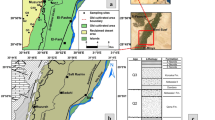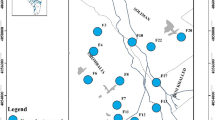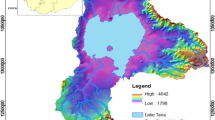Abstract
In the light of progressive depletion of groundwater reservoir and water quality deterioration of the Independence aquifer, an investigation on chemical data of dissolved major and minor constituents in 246 recent groundwater samples was performed. The main objective was the detection of processes responsible for the geochemical evolution and mineralization throughout the area. Multivariate techniques revealed different sources of solutes (a) dissolution of calcium and magnesium carbonate minerals, (b) weathering of acid volcanic minerals, (c) alteration of manganese containing alkaline silicates, (d) leaching of halite deposits of meteoric origin, (e) contamination from agricultural and urban wastewaters, and (f) evaporative effects due to intensive irrigation. Although nitrate contamination is associated with pollution from intensive cultivated areas, natural contamination plays an important role in the study area. The investigation reveals that weathering of acid volcanic rocks (rhyolite) and oxidation of arsenic bearing sulfide minerals are the responsible processes for high fluorine (up to 16 mg/l) and arsenic (up to 0.12 mg/l) contents, respectively, exceeding the Mexican maximum admissible concentration for drinking water. Except for kaolinite, all recharge processes are dissolution oriented (CO2, calcite, dolomite, K-feldspar, plagioclase). Silicate precipitation (amorphous silica and chalcedony) is of growing importance in discharge zones. Cation exchange is not an important issue in the whole study area.






Similar content being viewed by others
References
Aiuppa A, Bellomo S, Brusca L, D’Alessandro W, Federico C (2003) Natural and anthropogenic factors affecting groundwater quality of an active volcano. Appl Geochem 18:863–882
Alanis-Ruiz E (2002) Evolución geológica de la Cuenca de la Independencia y sus alrededores, Estado de Guanajuato, México (Geologic evolution of the Independence Basin and its surroundings, Guanajuato State, Mexico). B.th. Facultad de Ingeniería, Universidad Nacional Autónoma de México, Mexico City, Mexico, 96 pp
Appelo CAJ, Postma D (1993) Geochemistry, groundwater and pollution. Balkemia, Rotterdam, 536 pp
Aranda-Gómez JJ, Aranda-Gómez JM, Nieto-Samaniego AF (1989) Consideraciones acerca de la evolución tectónica durante el Cenozoico de la Sierra de Guanajuato y la parte meridional de la Mesa Central (Considerations about the tectonic evolution of the Sierra de Guanajuato and the Mesa Central during the Cenozoic Era). Revista de Instituto de Geología, Universidad Nacional Autónoma de México 8(1):33–46
Armienta MA, Villaseñor G, Rodriguez R, Ongley LK, Mango H (2001) The role of arsenic bearing rocks in groundwater pollution at Zimapán Valley, México. Environ Geol 40:571–581
Barrodale I, Roberts FDK (1980) L1 solution to linear equations subject to linear equality and inequality constraints. Ass Comp Mach, Transactions Math Software 6:231–235
Berner RA (1981) A new geochemical classification of sedimentary environments. J Sed Petrol 51:359–365
Blaney HF, Criddle WD (1950) Determining water requirements in irrigated areas from climatological and irrigation data. United States Department of Agriculture and Soil Conservation Service, report T.P. 96
Carrillo-Rivera JJ, Clark ID, Fritz P (1992) Investigating recharge of shallow and paleogroundwaters in the Villa de Reyes Basin, SLP, México, with environmental isotopes. Appl Hydrogeol 4:35–48
Carrillo-Rivera JJ, Cardona A, Edmunds WM (2002) Use of abstraction regime and knowledge of hydrogeological conditions to control high-fluoride concentration in abstracted groundwater: San Luis Potosí basin, Mexico. J Hydrol 261:24–47
Castellanos JZ, Ortega-Guerrero A, Grajeda OA, Vázquez-Alarcón A, Villalobos S, Muñoz-Ramos JJ, Zamudio B, Martínez JG, Hurtado B, Vargas P, Enríquez SA (2002) Changes in the quality of groundwater for agricultural use in Guanajuato. Terra 20:161–170
CEASG (1999) Estudio hidrogeológico y modelo matemático del Acuífero del Río Laja-San Felipe (A hydrogeological study and mathematical model of the Río Laja-San Felipe aquifer). Prof Rep, Comisión Estatal del Agua de Guanajuato, Mexico (Contract no. CEAS-APA-GTO-98–002)
Clark ID, Fritz P (1997) Environmental isotopes in hydrogeology. Lewis, New York, 329 pp
CNA (1992) Sinopsis geohidrológica del Estado de Guanajuato, 1992 (Geohydrologic synopsis of Guanajuato State). Gerencia de Aguas Subterráneas, Comisión Nacional del Agua (CNA), México City, México
CODEREG (2000) Acuífero de la Independencia, municipios de San José Iturbide, Doctor Mora, San Luis de la Paz, Dolores Hidalgo, San Felipe, San Diego de la Unión y San Miguel de Allende, Guanajuato (Independence aquifer, municipalities of San José Iturbide, Doctor Mora, San Luis de la Paz, Dolores Hidalgo, San Felipe, San Diego de la Unión and San Miguel de Allende, Guanajuato). Consejo para el Desarrollo Regional Noreste y Norte, Guanajuato, Mexico, 107 pp
Cortés A, Durazo J, Farvolden R (1997) Studies of isotopic hydrology of the Basin of Mexico and the vicinity: annotated bibliography and interpretation. J Hydrol 198:346–376
Drever JI (1997) The geochemistry of natural waters, 3rd edn. Prentice Hall, Englewood Cliffs, New Jersey
Echegoyén-Sanchez J, Romero-Martínez S, Velásquez-Silva S (1970) Geología y yacimientos minerales en la parte central del Distrito Minero de Guanajuato (Geology and mineral ores in the central part of the Guanajuato mining district). Consejo de Recursos Naturales No Renovables, México. Boletín 75, 36 pp
Ferrari L, Garduño VH, Pasquaré G, Tibaldi A (1994) Volcanic and tectonic evolution of central Mexico: Oligocene to present. Geofísica Internacional 33(1):91–105
Güler C, Thyne GD, McCray JE, Turner AK (2002) Evaluation of graphical and multivariate statistical methods for classification of water chemistry data. Hydrogeol J 10:455–474
Hem JD (1989) Study and interpretation of the chemical characteristics of natural water, 3rd edn. US Geol Surv Water-Sup Pap 2254, 263 pp. http://water.usgs.gov/pubs/
Holloway JM, Dahlgren RA, Hansen B, Casey WH (1998) Contribution of bedrock nitrogen to high nitrate concentrations in stream water. Nature 395:785–788
INEGI (1998) Estudio hidrológico del Estado de Guanajuato (A hydrological study of Guanajuato State). Instituto Nacional de Estadística Geografía e Informática (INEGI), ISBN 970–13–1916–8, Aguascalientes, Ags., Mexico
Mahlknecht J (2003) Estimation of recharge in the Independence aquifer, central Mexico, by combining geochemical and groundwater flow models. PhD Thesis, Institute of Applied Geology, University of Agricultural and Life Sciences (BOKU) Vienna, Austria, 296 pp
Mahlknecht J, Schneider JF, Tesch R, Bernasconi SM (2002) Recharge estimation from the combination of numerical flow modeling and combined CFC and radiocarbon dating of groundwater. In: Kovar K, Hrkal Z (eds) ModelCARE 2002 Proc 4th Int Conf Calibration and Reliability in Groundwater Modeling, June 2002, Prague, pp 611–614
Mahlknecht J, Schneider JF, Broder JM, Navarro de León I, Bernasconi SM (2003) Groundwater recharge in a sedimentary basin in semi-arid Mexico. Hydrogeol J (in review)
Medina-Mejía MG (2003) Estudio hidrogeoquímico de la Cuenca Alta del Río Laja: Municipio de San Miguel de Allende (A hydrogeochemical study of the upper Laja River: Municipality of San Miguel de Allende). M.Sc. Thesis, Departamento de Ciencias Básicas, Universidad Iberoamericana, Campus León, León, Mexico
Merkel B, Sperling B (1998) DVWK-Schriften 117, Hydrogeochemische Stoffsysteme II. Wirtschaft- und Verlagsgemeinschaft Gas und Wasser gmbH, Bonn, Germany (in german)
Monod O, Lapierre H, Chiodi M, Martínez J, Calvet P, Ortíz E, Zimmermann JL (1990) Reconstitution dín arc insulaire intra-océanique au Mexique central: la séquence volcano-plutonique de Guanajuato (Crétacé inférieur). Tectonique 310(II):45–51 (in French)
Mook WG (1980) Carbon-14 in hydrogeological studies. In: Fritz P, Fontes JC (eds) Handbook of environmental isotope geochemistry. The terrestrial environment, vol 1. Elsevier, Amsterdam, pp 49–74
Nieto-Samaniego AF, Macías-Romo C, Alaniz-Alvarez SA (1996) Nuevas edades isotópicas de la cubierta volcánica cenozoica de la parte meridional de la Mesa Central, México. Universidad Nacional Autónoma de México, Instituto de Geología, Revista Mexicana de Ciencias Geológicas 13(1):117–122 (in Spanish)
Ornelas-Soto (2003) Caracterización de la química y mineralogía de suelos y rocas en la zona de San Miguel de Allende (Characterization of chemistry and mineralogy of soils and rocks in the San Miguel de Allende zone). B Thesis, Instituto de Química, Universidad de Guanajuato, Guanajuato, Mexico
Ortega-Guerrero MA, Castellanos JZ, Aguilar R, Vázquez-Alarcón A, Alanis E, Vargas C, Urrutia F (2002) A conceptual model for increases of sodium, SAR, alkalinity, and pH at the Independence aquifer in Guanajuato. Terra 20:199–207
Parkhurst DL, Appelo AAJ (1999) User’s guide to PHREEQC (version 2) – A computer program for speciation, batch-reaction, one-dimensional transport, and inverse geochemical modeling. US Geol Surv, Wat-Resour Invest 99–4259 (http://wwwbrr.cr.usgs.gov/projects/GWC_coupled/phreeqc)
Parkhurst DL, Christenson S, Breit GN (1996) Ground-water-quality assessment of the Central Oklahoma Aquifer, Oklahoma – geochemical and geohydrologic investigations. US Geol Surv Water-Supply Pap 2357
Pérez-Venzor JA, Aranda-Gómez JJ, Mc Dowell F, Solorio Munguía JG (1996) Geología del Volcán Palo Huérfano, Guanajuato, México (Geology of the Palo Huerfano volcano, Guanajuato, Mexico). Universidad Nacional Autónoma de México, Instituto de Geología, Revista de Ciencias Geológicas 13(2):174–183
Phillips FM, Tansey MK, Peeters LA, Cheng S, Long A (1989) An isotopic investigation of groundwater in the Central San Juan Basin, New Mexico: Carbon 14 dating as a basis for numerical flow modeling. Water Resour Res 25:2259–2273
Planer-Friedrich B (2002) Hydrogeological and hydrogeochemical investigations in the Rioverde Basin, Mexico. Freiberg On-line Geoscience, vol 3, Institute of Geology, University of Mining and Technology Freiberg, Germany (http://www.geo.tu-freiberg.de/fog/issues.html)
Planer-Friedrich B, Armienta MA, Merkel BJ (2001) Origin of arsenic in groundwater of the Rioverde Basin. Environ Geol 40:1290–1298
Plummer LN, Back W (1980) The mass balance approach: applications to interpreting the chemical evolution of hydrologic systems. Am J Sci 280:130–142
Plummer LN, Prestemon EC, Parkhurst DL (1991) An interactive code (NETPATH) for modeling net geochemical reactions along a flow path. US Geol Surv Water-Res Invest 91–4078
Ramos-Ramírez E, Gúzman Andrade JJ, Sandoval Juárez MC, Gallaga-Ortega Y (2002) Caracterización de arcillas del estado de Guanajuato y su potencial aplicación en cerámica (Characterization of clays in the Guanajuato State and its potential application for ceramics). Universidad de Guanajuato, Acta Universitaria 12(1):23–30
Ruiz J, Kessler SE, Jones LM, Sutter JF (1989) Geology and geochemistry of the Las Cuevas fluorite deposit, San Luis Potosí, Mexico. Econ Geol 75:1200–1209
SARH (1981) Informe geológico preliminar de las cuencas de los Municipios de Dr Mora y San Luis de la Paz, Gto. (Preliminary geohydrologic report about the basins of the Dr Mora and San Luis de la Paz municipalities, Guanajuato). Secretaría de Recursos Hidráulicos (SARH), Jefatura de Irrigación y Control de Ríos, Dirección de Aguas Subterráneas, Guanajuato, Mexico
SPSS (1999) SPSS for Windows Release 10.0.1, SPSS, Chicago, Illinois
SSA (2000) Modificación a la Norma Oficial Mexicana NOM-127-SSA1–1994, Salud ambiental. Agua para uso y consumo humano. Límites permisibles de calidad y tratamientos a que debe someterse el agua para su potabilización. Secretaría de Salud y Ambiente (SSA), Mexico City, Mexico (http://www.ssa.gob.mx/unidades/dirgsa/noms)
Thorstenson DC, Weeks EP, Hass H, Fisher DW (1983) Distribution of gaseous 12CO2, 13CO2, 14CO2 in the sub-soil unsaturated zone of western U.S. Great Plains. Radiocarbon 25:315–346
Turc L (1954) Le bilan d’eau des sols; relations entre les précipitations, l’évaporation et l’écoulement. La Houille blanche, 3 journées de l’hydraulique de la Société Hydrotechnique de France, Paris, pp 36–44
Tuta ZH, Sutter JF, Kesler SE, Ruiz J (1988) Geochronology of mercury, tin, and fluorite mineralization in northern Mexico. Econ Geol 83:1931–1942
Vasallo LF, Martínez-Reyes J, Pierre Paris J (1996) Estructuras circulares y lineales en el distrito minero de Guanajuato, México y su significado en la prospección minera (Circular and linear structures in the mining district Guanajuato, Mexico, and its significance for mining). Universidad Nacional Autónoma de México, Instituto de Geología, Revista Mexicana de Ciencias Geológicas 13(2):252–257
Ward JH (1963) Hierarchical grouping to optimize an objective function. J Am Stat Assoc 69:236–244
Acknowledgements
The University of Agricultural Sciences (BOKU), Vienna, Austria, and the National Autonomous University of Mexico (UNAM), Mexico, are thanked for the grants given to J. Mahlknecht at the first stage of this investigation. B. Steinich recognizes support from the Direccion General de Asuntos del Personal Academico of UNAM (DGAPA-UNAM, Grant IN121199). Thanks are also due to the “Programa de Mejoramiento de Personal Académico – Universidad Autónoma de Nuevo León” for the Ph.D. scholarship (I. Navarro de León). Access to relevant data and studies have been facilitated by the Consejo para el Desarrollo Regional Noreste (CODEREG Noreste) and the Comisión Estatal del Agua de Guanajuato (CEAG).
Author information
Authors and Affiliations
Corresponding author
Rights and permissions
About this article
Cite this article
Mahlknecht, J., Steinich, B. & Navarro de León, I. Groundwater chemistry and mass transfers in the Independence aquifer, central Mexico, by using multivariate statistics and mass-balance models. Env Geol 45, 781–795 (2004). https://doi.org/10.1007/s00254-003-0938-3
Received:
Accepted:
Published:
Issue Date:
DOI: https://doi.org/10.1007/s00254-003-0938-3




